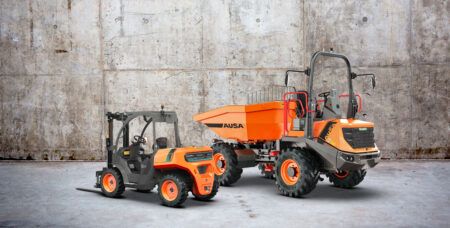Volvo Construction Equipment presented the company’s prototype electric hybrid wheeled loader at a special event in Eskilstuna, Sweden, this week. The company gave customers, the international press, government representatives and academics an exclusive look at the machine, which can deliver up to a 50% improvement in fuel efficiency. On top of this, the LX1 also offers a significant reduction in emissions and noise pollution compared with its conventional counterparts.
The LX1 is a series hybrid that incorporates a driveline that consists of electric drive motors mounted at the wheels, electric hydraulics, an energy storage system, a significantly smaller diesel engine and new machine architecture. It’s this combination that enables the substantial gain in fuel efficiency. The prototype which has 98% new parts and a fundamentally new machine design is capable of doing the work of a wheel loader that’s one size larger. At this stage, the LX1 is part of a research project and it is not commercially available.
The Volvo Group defines electromobility as ‘commercial vehicles and machines that can utilize an electrical motor to propel or to perform the main purpose of the machine’. A hybrid is classified as a machine that uses more than one power source and captures and reuses energy that would otherwise be wasted. It is a pre-requisite that the machine has the capability for energy storage to count as a true hybrid.
Volvo CE started its journey with electromobility and hybrid technology in 1998. The company has long-term plans to develop products and services for electromobility, including electric hybrids and electric sites.
“Although we believe that there will be a major shift toward electric hybrid technology in the future, our customers, quite rightly, want improved efficiency now. We are delivering this through more conventional technologies and soft offers,” says Scott Young, electromobility program manager at Volvo CE.
“This is because we need to meet customers’ immediate expectations in terms of total cost of ownership (TCO). A large part of TCO is energy cost, but other significant expenses include purchase price and maintenance. These aspects help drive our hybrid development plans. Therefore, before we launch a machine like the LX1, you can expect to see elements of this design incorporated into our products. This supports short and mid-term developments and requirements while the market continues to accept the technology, technology improves and the cost of new technologies decreases.”
The OEM also presented its electric site solution, unveiling the new concept HX1 autonomous, battery electric, load carrier at the Xploration Forum. The prototype machine is one element of an electric site research project that predicts up to a 95% reduction in carbon emissions and up to a 25% reduction in total cost of ownership. The project aims to electrify a transport stage in a quarry from excavation to primary crushing and transport to secondary crushing. It involves developing new machines, work methods and site management systems. As well as a fleet of HX1s, other prototype machines that make-up the electric site system include the LX1 hybrid wheel loader and a grid-connected excavator. New technology encompasses machine and fleet control systems and logistic solutions for electric machines in quarries.
“This research project is a step towards transforming the quarry and aggregates industry,” says Johan Sjöberg, technical specialist in site automation at Volvo CE. “By using electricity instead of diesel to power construction equipment in a quarry we have the potential to deliver significant reductions in fuel consumption, CO2 emissions, environmental impact and cost-per-tonne. The electrification of construction equipment will produce cleaner, quieter and more efficient machines this represents the future of our industry.”
September 16, 2016




